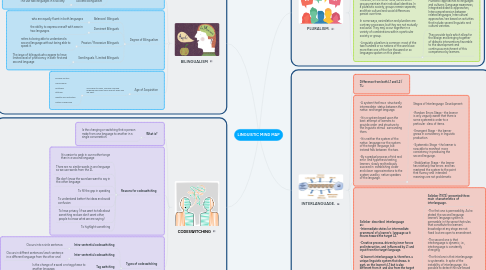
1. BILINGUALISM
1.1. Bilingualism is the ability to use two languages
1.1.1. Individual Bilingualism
1.1.1.1. who knows and practises two languages at sensibly the same level, and with the same spontaneousness
1.1.2. Societal Bilingualism
1.1.2.1. The use two languages in a society.
1.2. Degree of Bilingualism
1.2.1. Balanced Bilinguals
1.2.1.1. who are equally fluent in both languages
1.2.2. Dominant Bilinguals
1.2.2.1. the ability to express oneself with ease in two languages.
1.2.3. Passive / Recessive Bilinguals
1.2.3.1. refers to being able to understand a second language without being able to speak it.
1.2.4. Semilinguals / Limited Bilinguals
1.2.4.1. The issue of bilinguals who appear to have limited level of proficiency in both first and second language
1.3. Age of Acquisition
1.3.1. According to many, learning a second language becomes more difficult when you are adult.
1.3.1.1. Possible factors: Neurological Aptitudes Attitude Identity and motivation Nature of exposure
2. CODESWITCHING
2.1. What is?
2.1.1. Is the changing or switching that a person make from one language to another in a single conversation.
2.2. Reasons for codeswitching
2.2.1. It is easier to peak in our mother tonge than in a second language
2.2.2. There are no similar words in one language so we use words from the 2L
2.2.3. We don't know the word we want to say in the other language
2.2.4. To fill the gap in speaking
2.2.5. To understand better the ideas and avoid confusion
2.2.6. To have privacy (if we want to talk about something and we don't want other people to know what we are saying)
2.2.7. To highlight something
2.3. Types of codeswitching
2.3.1. Intra-sentential codeswitching
2.3.1.1. Occurs into a sinle sentence.
2.3.2. Inter-sentential codeswitching
2.3.2.1. Occurs in diffrent sentences (each sentence in a different language from the other one)
2.3.3. Tag switching
2.3.3.1. Is the change of a word or a tag phrase to another language.
2.3.4. Intralexical codeswitching
2.3.4.1. Is the change of pronunciation of words to ''addapt'' them to the pronunciation of the other language.
3. PLURALISM.
3.1. What is pluralism? When more than one language used in a specific area.
3.2. Pluralism, on the other hand, exists when groups maintain their individual identities. In a pluralistic society, groups remain separate, and their cultural and social differences persist over time. In some ways, assimilation and pluralism are contrary processes, but they are not mutually exclusive. They may occur together in a variety of combinations within a particular society or group. -Linguistic pluralism is common: most of the two hundred or so nations of the world use more than one of the five thousand or so languages spoken on this planet.
3.2.1. Pluralistic approaches to languages and cultures (Language awareness, Integrated didactic approaches, Intercomprehension between related languages, Intercultural approaches) are based on activities that include several linguistic and cultural varieties.
3.2.2. They provide tools which allow for the design and bringing together of didactic interventions favorable to the development and continuous enrichment of this competence by learners.
4. INTERLANGUAGE.
4.1. Difference from both L1 and L2 / TL:
4.2. -A system that has a structurally intermediate status between the native and target language. -It is a system based upon the best attempt of learners to provide order and structure to the linguistic stimuli surrounding them. -It is neither the system of the native language nor the system of the target language, but instead falls between the two. -By a gradual process of trial and error and hypothesis testing, learners slowly and tediously succeed in establishing closer and closer approximations to the system used by native speakers of the language.
4.2.1. Stages of Interlanguage Development:
4.2.2. -Random Errors Stage - the learner is only vaguely aware that there is some systematic order to a particular class of items. -Emergent Stage - the learner grows in consistency in linguistic production. -Systematic Stage - the learner is now able to manifest more consistency in producing the second language. -Stabilization Stage - the learner has relatively few errors and has mastered the system to the point that fluency and intended meanings are not problematic
4.3. Selinker described interlanguage as: -Intermediate states (or intermediate grammars) of a learner’s language as it moves toward the target L2. -Creative process, driven by inner forces and interaction, and influenced by L1 and input from the target language. -A learner’s interlanguage is, therefore, a unique linguistic system that draws, in part, on the learner’s L1 but is also different from it and also from the target language.
4.3.1. Selinker (1972) presented three main characteristics of interlanguage.
4.3.2. -The first one is permeability. As he stated, the second language learners’ language system is permeable, in the sense that rules that constitute the learners’ knowledge at any stage are not fixed but are open to amendment. -The second one is that interlanguage is dynamic, i.e., interlanguage is constantly changing. -The third one is that interlanguage is systematic. In spite of the instability of interlanguage, it is possible to detect the rule-based nature of the learner’s interlanguage.
4.3.3. Apart from the above mentioned characteristics, variability is another characteristic that can not be neglected. This variability is evident both synchronically and diachronically.
